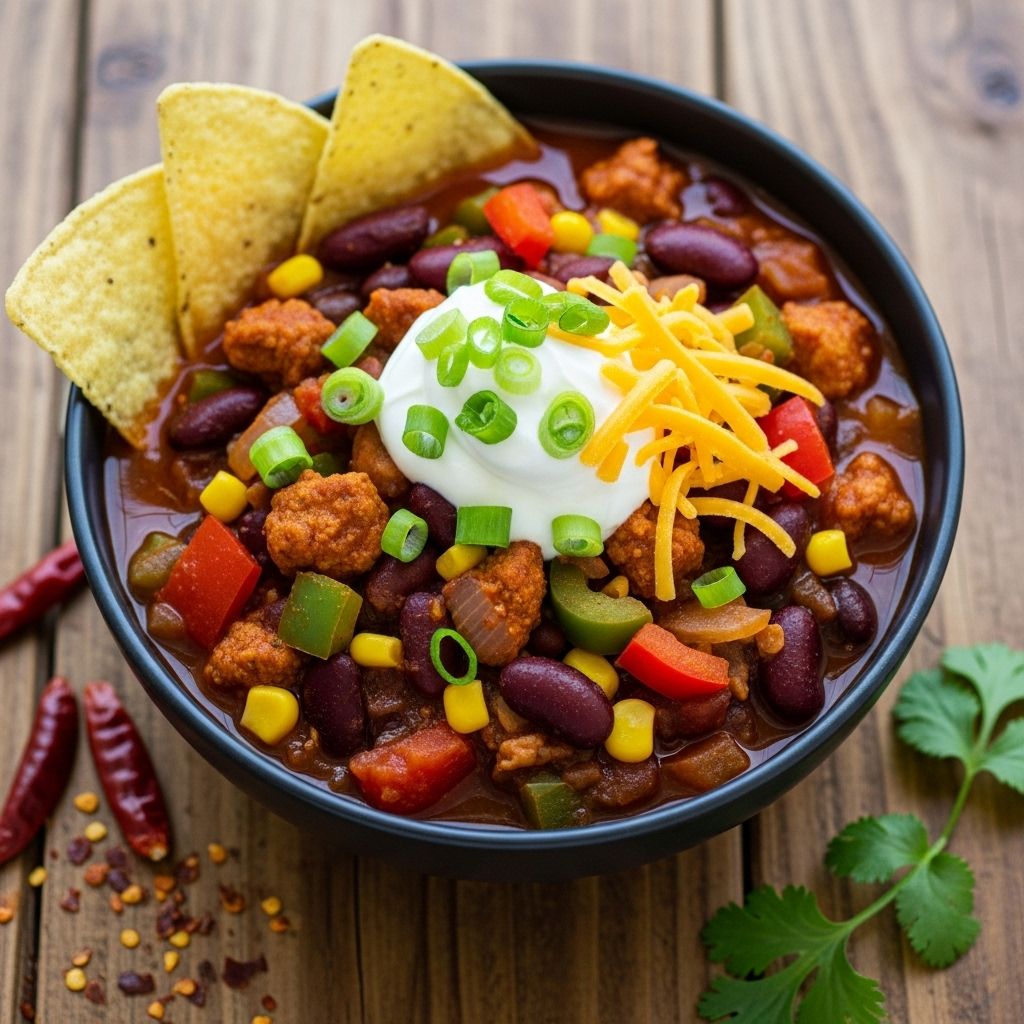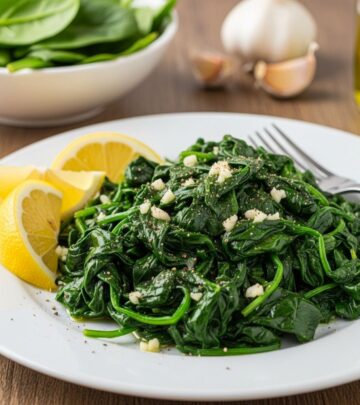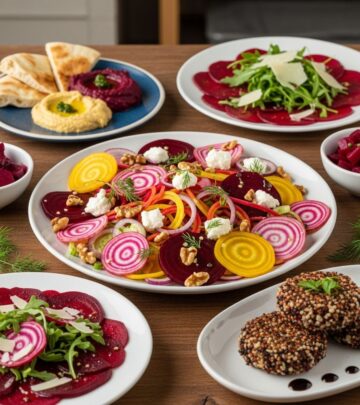Ultimate Veggie Chili Recipe: Hearty Plant-Based Comfort
A plant-powered twist on classic comfort food that packs big flavor in every spoonful.

When it comes to comfort food that satisfies both vegetarians and meat-eaters alike, few dishes can compete with a well-made veggie chili. This hearty, flavorful dish proves that plant-based meals can be just as satisfying and delicious as their meat-containing counterparts. Whether you’re looking to incorporate more vegetables into your diet, feeding a crowd, or simply craving a warm, comforting bowl of goodness, veggie chili delivers on all fronts.
What Makes the Perfect Veggie Chili
The secret to exceptional veggie chili lies in building layers of flavor while maintaining a satisfying texture that doesn’t leave you missing the meat. Unlike traditional chili that relies on ground beef or turkey for substance, vegetarian chili draws its heartiness from a combination of beans, vegetables, and carefully selected spices that create depth and complexity.
Key components of great veggie chili include:
A robust base of aromatic vegetables like onions, bell peppers, and garlic creates the foundation. These vegetables are sautéed until they develop a slight caramelization, which adds sweetness and depth to the overall flavor profile. The addition of mushrooms provides an umami-rich element that mimics some of the savory qualities typically found in meat-based chilis.
Multiple varieties of beans not only add protein and fiber but also contribute different textures and flavors. Black beans offer a creamy consistency when cooked, while kidney beans maintain their shape and provide a slightly firmer bite. Pinto beans add their own unique flavor and help create a varied, interesting texture throughout the dish.
Essential Ingredients for Veggie Chili
The beauty of veggie chili lies in its flexibility, but certain ingredients are essential for achieving the perfect balance of flavors and textures. Understanding these core components will help you create a chili that’s both satisfying and delicious.
Base Vegetables
Start with a classic mirepoix foundation of onions, carrots, and celery, enhanced with bell peppers for sweetness and color. Red onions work particularly well as they become sweeter when cooked and add a subtle complexity. Sweet potatoes can be diced and added for natural sweetness and additional heartiness, while mushrooms provide that essential umami flavor that makes the chili more satisfying.
Bean Varieties
Using multiple types of beans creates textural interest and ensures the chili feels substantial. Black beans are creamy and mild, kidney beans hold their shape well and have a slightly nutty flavor, and pinto beans add earthiness. Chickpeas can also be included for additional protein and a different texture. Always drain and rinse canned beans to remove excess sodium and starch.
Spice Blend
The spice mixture is where veggie chili truly shines. Chili powder forms the base, but adding cumin provides warmth and earthiness. Smoked paprika contributes a subtle smokiness that adds depth without overwhelming heat. Oregano brings an herbal note, while a touch of cocoa powder adds richness and complexity. Cayenne pepper can be adjusted to taste for heat level.
Step-by-Step Cooking Method
Creating the perfect veggie chili requires patience and attention to building flavors at each stage. The process involves layering ingredients and allowing each component to contribute its unique characteristics to the overall dish.
Building the Base
Heat olive oil in a large, heavy-bottomed pot or Dutch oven over medium heat. The key is to use enough oil to properly sauté the vegetables without making the dish greasy. Add the chopped onions first, cooking them until they become translucent and slightly golden. This usually takes about 5-7 minutes and is crucial for developing the chili’s foundational flavor.
Next, add the diced sweet potatoes and continue cooking for another 3-4 minutes. The sweet potatoes should start to soften slightly but maintain their shape. Add the mushrooms and cauliflower if using, seasoning with salt to help draw out moisture and concentrate flavors.
Spice Integration
Once the vegetables have softened, add the minced garlic and cook for about 30 seconds until fragrant. This is the perfect time to add the spice blend – chili powder, cumin, smoked paprika, and oregano. Cook the spices with the vegetables for about a minute, stirring constantly to prevent burning. This process, known as blooming the spices, releases their essential oils and intensifies their flavors.
Add soy sauce and brown sugar at this stage. The soy sauce provides umami depth that compensates for the absence of meat, while the brown sugar balances the acidity of the tomatoes and adds subtle sweetness.
Adding Liquids and Beans
Pour in the diced tomatoes with their juice, tomato puree, and vegetable broth. The combination of different tomato products creates complexity – diced tomatoes provide texture while puree creates a smooth base. Bring the mixture to a boil over medium-high heat, then add all the beans and the bay leaf.
Reduce the heat to medium-low and let the chili simmer for 25-30 minutes, stirring occasionally. This allows all the flavors to meld together and the vegetables to become tender. The chili should thicken slightly as it cooks, but it shouldn’t become too thick or paste-like.
Flavor Enhancement Techniques
Several techniques can elevate your veggie chili from good to extraordinary. These methods focus on building complexity and ensuring every spoonful is packed with flavor.
Umami Boosters
Since vegetarian dishes can sometimes lack the savory depth that meat provides, incorporating umami-rich ingredients is crucial. Soy sauce is an obvious choice, but consider adding a tablespoon of tomato paste and cooking it with the spices for added depth. Mushroom powder or dried mushrooms that have been rehydrated and chopped can also intensify the savory flavors.
Acid Balance
A splash of apple cider vinegar or lime juice added at the end of cooking brightens all the flavors and prevents the chili from tasting flat. The acid helps balance the richness of the beans and the sweetness from the vegetables and brown sugar.
Heat Management
Controlling the heat level is important for making chili that appeals to a wide range of palates. Start conservatively with spices and build heat gradually. Remember that dried chiles can vary significantly in heat level, so taste as you go. For those who want more heat, offer hot sauce or sliced jalapeños as garnishes.
Serving Suggestions and Toppings
The right toppings can transform a simple bowl of chili into a complete, restaurant-quality meal. Traditional toppings work beautifully with veggie chili, but there are also unique options that complement the plant-based nature of the dish.
Classic Toppings
Sour cream or Greek yogurt adds cooling richness that balances the spices. Shredded cheese – cheddar, Monterey Jack, or a Mexican blend – melts beautifully into the hot chili. Fresh chopped cilantro provides brightness and color, while diced avocado adds creaminess and healthy fats. Chopped green onions contribute a mild onion flavor and attractive color contrast.
Creative Additions
Consider offering cornbread or crusty bread for dipping. Tortilla chips provide textural contrast and turn the chili into a more casual, shareable dish. For a heartier meal, serve over baked sweet potatoes or brown rice. Pickled jalapeños add acidic heat, while a drizzle of hot honey can provide sweet heat for those who enjoy complex flavor combinations.
Storage and Meal Prep Tips
Veggie chili is an excellent candidate for meal preparation and batch cooking. The flavors actually improve after a day or two, making it perfect for advance preparation.
Refrigerator Storage
Allow the chili to cool completely before transferring to airtight containers. It will keep in the refrigerator for up to 5 days. When reheating, you may need to add a splash of broth or water as the chili tends to thicken when cold. Reheat gently over medium-low heat, stirring frequently to prevent scorching.
Freezer Instructions
Veggie chili freezes exceptionally well for up to 3 months. Freeze in portion-sized containers for easy single servings, or in larger containers for family meals. Thaw overnight in the refrigerator before reheating. Some vegetables may become slightly softer after freezing, but the flavor remains excellent.
Nutritional Benefits
Veggie chili is nutritionally dense and provides numerous health benefits. The combination of beans provides complete proteins when eaten together, while the variety of vegetables contributes essential vitamins, minerals, and fiber.
The high fiber content supports digestive health and helps maintain stable blood sugar levels. The antioxidants from the colorful vegetables and spices provide anti-inflammatory benefits. This dish is naturally low in saturated fat while being rich in plant-based proteins, making it heart-healthy and satisfying.
Recipe Variations
One of the greatest advantages of veggie chili is its adaptability. You can easily modify the recipe based on seasonal vegetables, personal preferences, or dietary restrictions.
Seasonal Adaptations
In fall and winter, add roasted butternut squash or parsnips for sweetness and heartiness. Summer versions can incorporate zucchini, corn kernels, and fresh tomatoes when they’re at their peak. Spring variations might include asparagus and fresh peas for a lighter, brighter flavor profile.
Protein Variations
For additional protein, consider adding crumbled tempeh, diced extra-firm tofu, or plant-based meat alternatives. Lentils – red, green, or black – can be added along with or instead of some beans for variety. Quinoa stirred in during the last few minutes of cooking adds complete protein and interesting texture.
Frequently Asked Questions
Q: Can I make this chili in a slow cooker?
A: Yes! Sauté the vegetables and spices first for best flavor, then transfer everything to a slow cooker. Cook on low for 6-8 hours or high for 3-4 hours. Add delicate vegetables like zucchini in the last hour.
Q: How can I make my veggie chili thicker?
A: Let it simmer uncovered to reduce liquid, mash some of the beans against the pot side, or mix 2 tablespoons of cornmeal or masa harina with water and stir in during the last 15 minutes.
Q: What’s the best way to add more heat?
A: Gradually add cayenne pepper, hot sauce, or finely diced jalapeños. For smokier heat, try chipotle peppers in adobo sauce. Always taste and adjust incrementally.
Q: Can I use dried beans instead of canned?
A: Absolutely! Soak dried beans overnight and cook them separately until tender before adding to the chili. This reduces sodium and allows better control over texture.
Q: Is this chili suitable for special diets?
A: Yes! It’s naturally vegetarian, vegan, gluten-free, and can be made oil-free by sautéing vegetables in broth instead of oil. It’s also naturally dairy-free before adding toppings.
References
- https://www.thepioneerwoman.com/food-cooking/recipes/a61923842/cauliflower-chili-recipe/
- https://www.thepioneerwoman.com/food-cooking/recipes/a38772396/black-bean-chili-recipe/
- https://www.thepioneerwoman.com/food-cooking/recipes/a45987835/sweet-potato-chili-recipe/
- https://www.thepioneerwoman.com/food-cooking/recipes/a11980/veggie-chili/
- https://www.foodfanatic.com/recipes/pioneer-woman-veggie-chili/
Read full bio of medha deb












